In the winter there is less opportunity to paint or draw on site. I use the time as an opportunity to improve paint technique and use photos or drawings of masters to inspire my artwork. I continue to work on a parsha (Torah portion) image each week. Lately, a few of my favorites have been birds or animals. Also, I joined a group on Facebook which offers prompts for each day. Not every prompt inspires me to paint or draw. But several have, and some of the better ones I will post on my blog or on the art database.
I do not have any pets currently; however, we do have a bird feeder outside our kitchen window. One of the prompts was bird on a wire. I like the idea of drawing directly from nature, but birds are too fast! It is hard to photograph them; you can see some of my past cardinal photos on this blog.
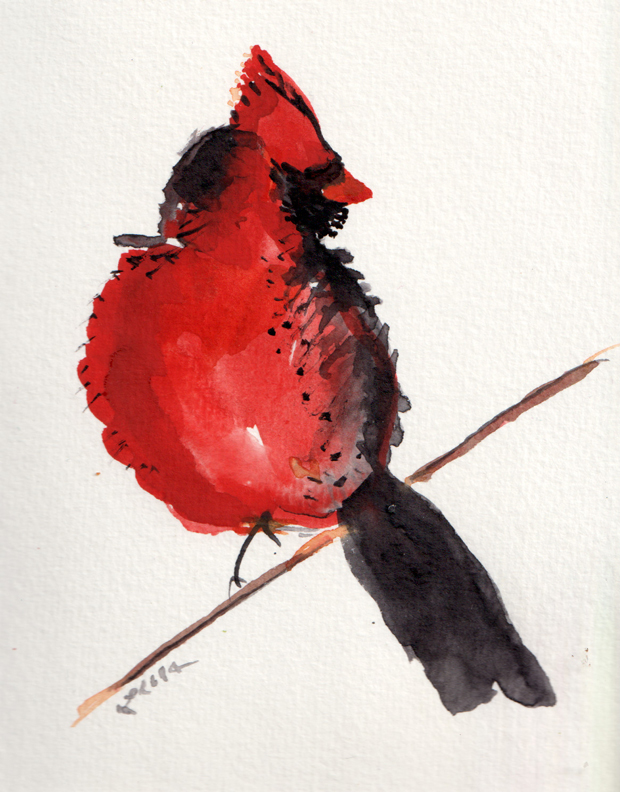
I painted this flaming red male cardinal from one of my photos when the prompt was Bird on a Wire.
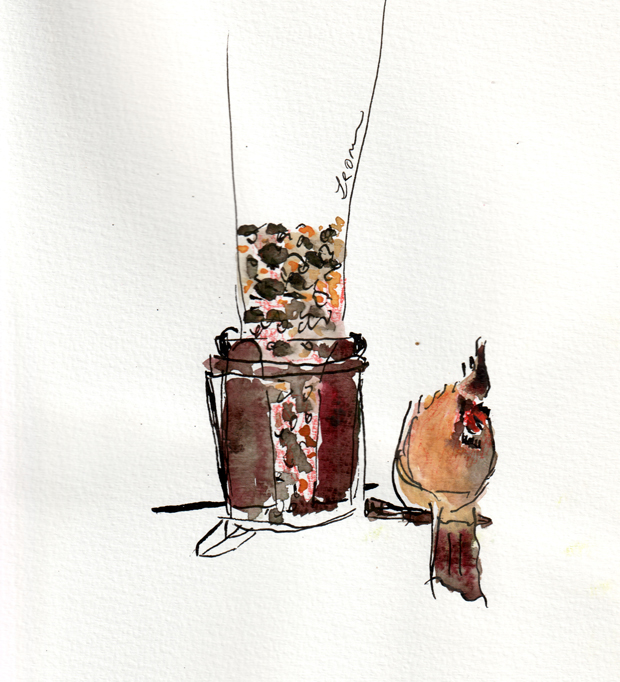
I drew and painted (watercolor, ink, and Derwent Inktense colored pencil on paper) this lady cardinal at a bird feeder in honor of parshat Beshalach, when there is a custom to feed the birds.
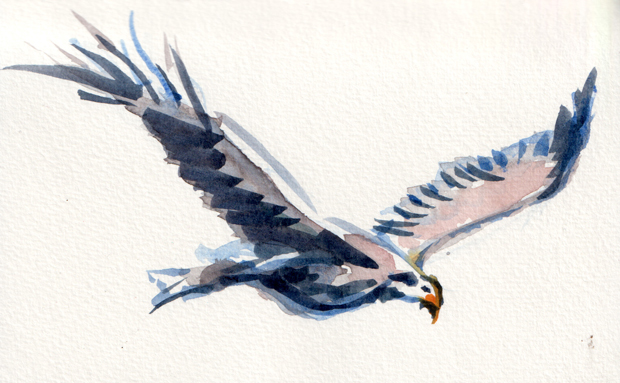
The next week was Parshat Yitro with the quote: And I bore you on eagles’ wings (Exodus 19:4). One eagle is just watercolor on the white of the paper.
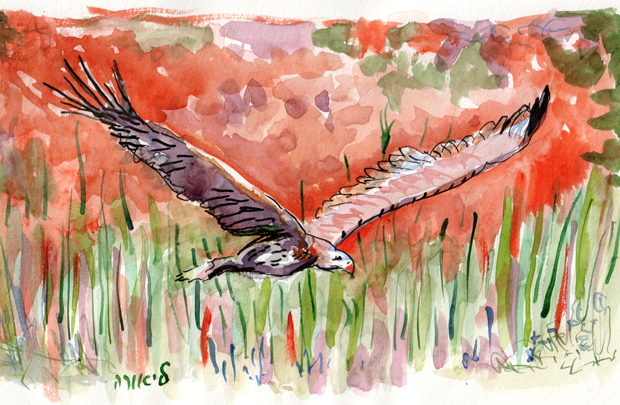
I also did an eagle with an orangey-red background. It came so orange that one friend thought the background was fire. She interpreted it as Israel on fire, and the eagle (perhaps God?) comes to our rescue.
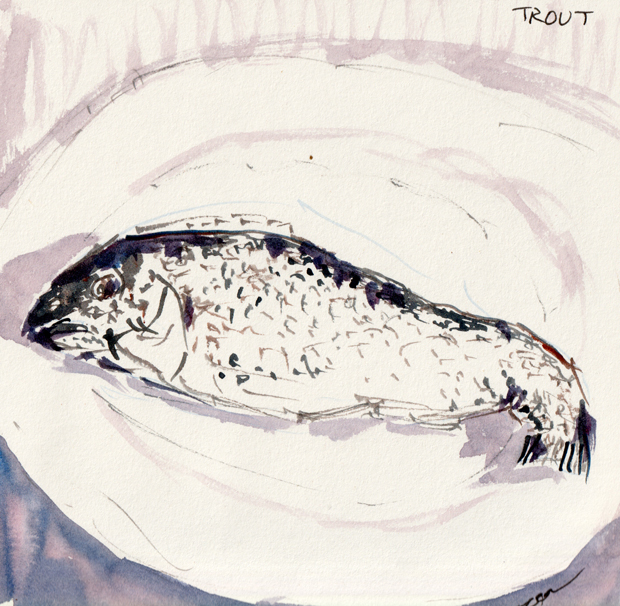
There was a prompt for fish. I painted the trout we had for dinner. Yes, that is all watercolor.
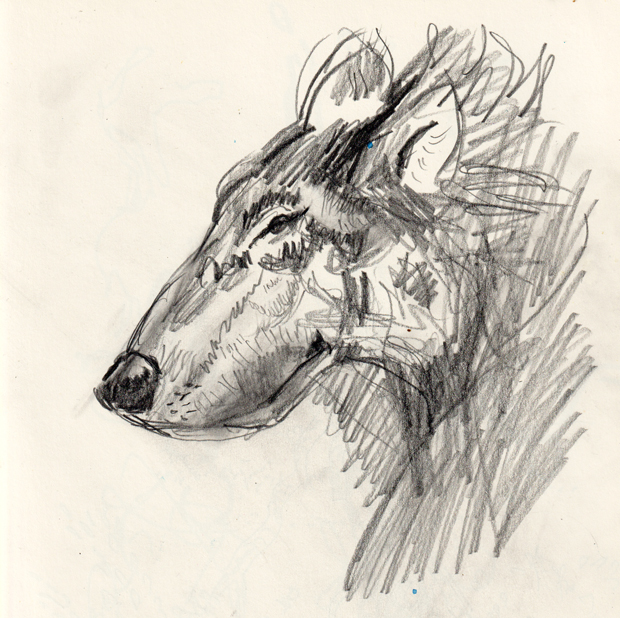
I will conclude with this pencil drawing of a wolf (copy of a drawing by Victor Ambrus), executed for parshat Vayechi 49:7.
Benjamin is a ravenous wolf;
In the morning he consumes the foe,
And in the evening he divides the spoil.”
בִּנְיָמִין֙ זְאֵ֣ב יִטְרָ֔ף בַּבֹּ֖קֶר יֹ֣אכַל עַ֑ד וְלָעֶ֖רֶב יְחַלֵּ֥ק שָׁלָֽל׃
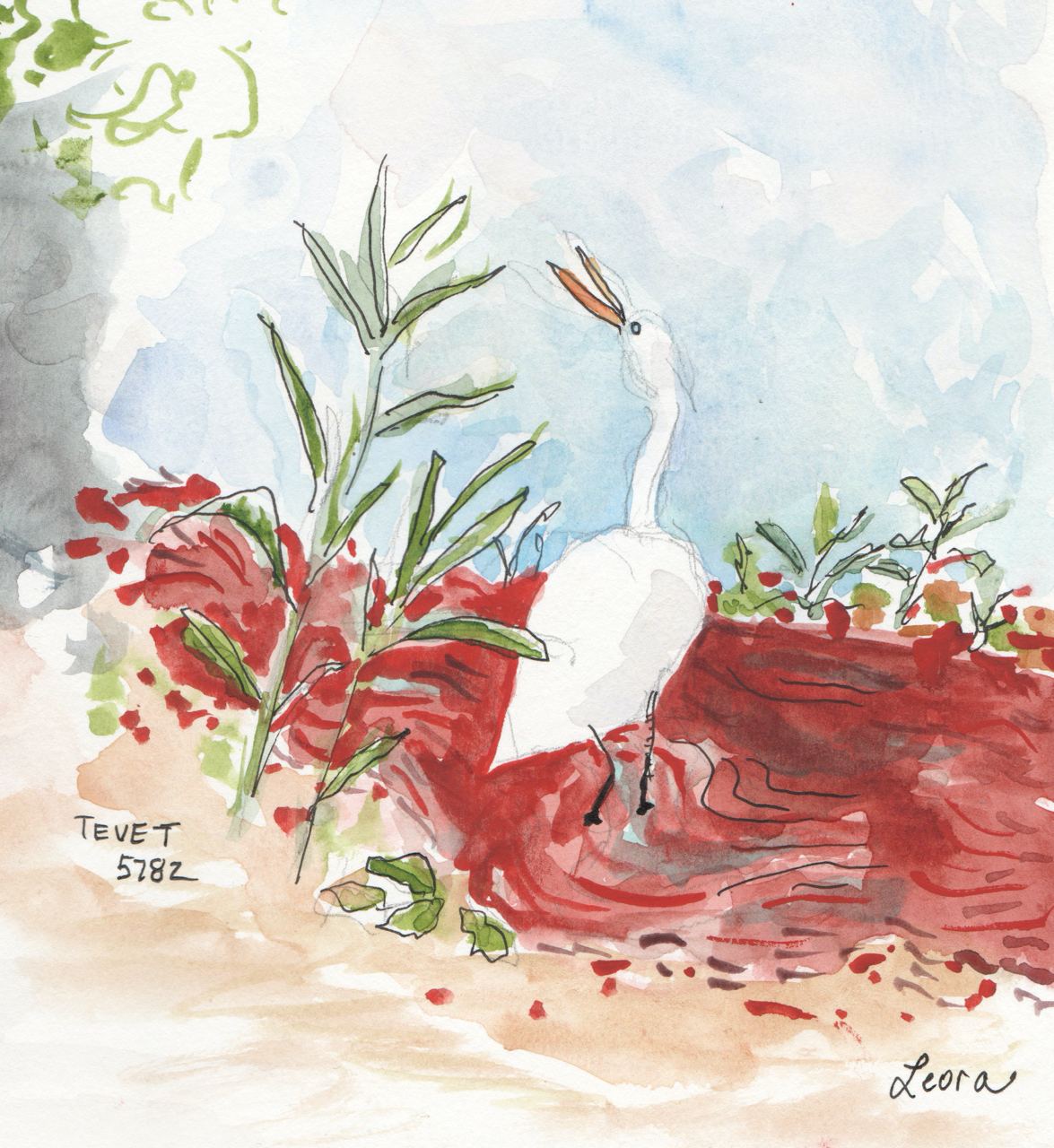
Why do art? And how does one get inspiration? For the first question, I will quote Aleksandr Solzhenitsyn at the end of this post. For the second, I will describe the process of how I created this watercolor.
I painted this watercolor in response to reading about Plague Number One: blood. How does one depict a bloody river Nile? A while back, I painted a dull straight river of blood. I wanted something more watery. I looked at paintings of Winslow Homer and J.M.W. Turner. Both are known for their water scenes. I happened upon a small museum book of Japanese paintings that belonged to my mother z”l. The covered showed an egret (at first, I thought it was a stork — I need to improve my birdwatching skills) bathing in a body of water. Actually, there are two egrets in the scene. I just focused on the right side. The reeds kind of look as how I would imagine greens growing next to the Nile might look. And my friend later told me indeed egrets are found in Egypt.
When I do biblical art, I recently started adding a snippet from a pasuk (a phrase of Torah) to the side of the art. Here is another version of this painting, one that cites the plague of blood:
Parshat Vaera, Shmot 7:21 “and the blood was throughout all the land of Egypt.”
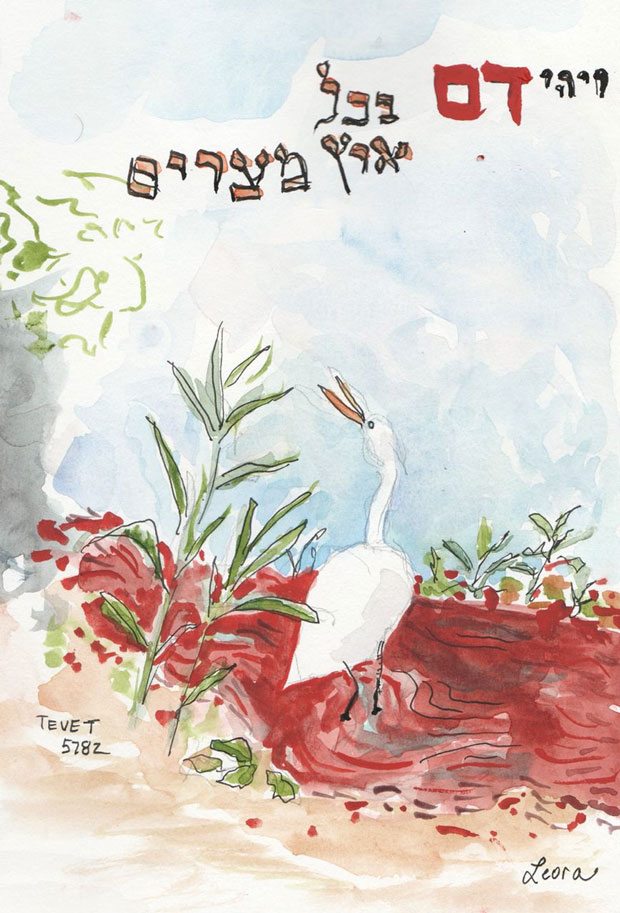
Quotes from Aleksandr Solzhenitsyn’s 1970 Nobel Lecture
Who was Aleksandr Solzhenitsyn? Aleksandr Solzhenitsyn was born in 1918 in Kislovodsk, Russia. In 1945 he was arrested for criticising Stalin in private correspondence and sentenced to an eight-year term in a labour camp, to be followed by permanent internal exile. The experience of the camps provided him with raw material for One Day in the Life of Ivan Denisovich, which he was permitted to publish in 1962. In 1970 he gave a lecture upon receiving the Nobel prize, and the main topic was art.
Not everything can be named. Some things draw us beyond words. Art can warm even a chilled and sunless soul to an exalted experience. Through art we occasionally receive–indistinctly, briefly–revelations the likes of which cannot be achieved by rational thought.
Later in the lecture:
But who will reconcile these scales of values and how? Who is going to give mankind a single system of evaluation for evil deeds and for good ones, for unbearable things and for tolerable ones–as we differentiate them today? Who will elucidate for mankind what really is burdensome and unbearable and merely chafes the skin due to its proximity? Who will direct anger toward that which is more fearsome rather than toward that which is closer at hand? Who could convey this understanding across the barriers of his own human experience? Who could impress upon a sluggish and obstinate human being someone else’s far off sorrows and joys, who could give him an insight into magnitude of events and into delusions which he has never himself experienced? Propaganda, coercion, and scientific proof are equally powerless here. But fortunately there does exist a means to this end in the world! It is art. It is literature.
Source: The Solzhenitsyn Reader, edited by Edward E. Ericson, Jr. and Daniel J. Mahoney

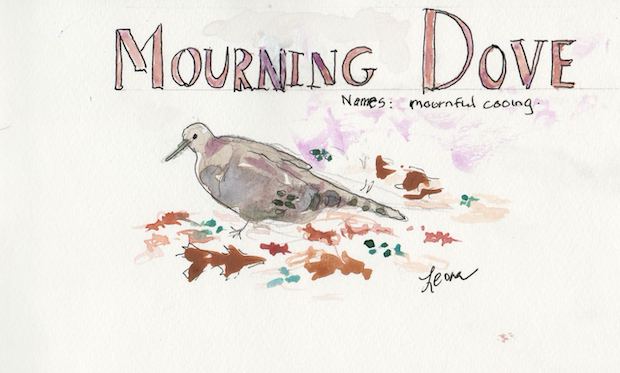
This week a mourning dove was wandering about my front yard. Instead of grabbing a camera and photographing the bird, I took my watercolor sketchpad (Travelogue Artist Watercolor Journal) and used a pencil and pen to draw the bird. I took it back in the house, added a little watercolor to the bird, went back out again to examine the mourning dove carefully. Yes, it did have those spots toward the tail. Yes, they were a shade of darkish gray. Yes, the beak was also darkish gray. Later I looked in my Birds of New Jersey Field Guide by Stan Tekiela and learned more:
Name comes from its mournful cooing. A ground feeder, bobbing its head as it walks. One of the few birds to drink without lifting head.
The one in my yard seemed to have a longer beak than the one pictured in the book.Also, I did not see the bright color in the head that Stan Tekiela showed in his photo. Adding a bit of lavender did seem to match the bird that I saw. However, as an artist one could also say using lavender was artistic license for either shadow or for gradations of hue or saturations.
Do you see birds in your yard? Do see distinguishing marks on the birds, whether color, spots or types of feathers?


Among the birds I saw at the Hula Valley in Israel: gallinule (moorhen), lapwing, egret, crane, pelican. My daughter saw a small blue bird fly by quickly twice – this may have been a kingfisher.
A bit of history about this magical (to me, at least) place in northern Israel:
Back in the 1950’s the malaria-ridden swamps of the Hula Valley were drained. However, this caused ecological damage. From the leaflet of the Hula Agamon Lake: “Over the years the peat earth that is typical of the Hula(organic earth the the remains of plants and animals) dried up, broke up, sunk, and even started to burn underground. The worst thing was that the phosphates and nitrates in the earth were washed into the Kinneret and polluted its waters.” In the 1990’s earth was restored; the project included digging canals that allowed the control of water in the area.
One of the major benefits of the 1990’s work was this ornithological spot, unique in the world. Over this area twice a year no less than 500 million birds migrate.
Learn more here: http://www.agamon-hula.co.il/?lang=en_US

This bird is a spur-winged lapwing or spur-winged plover.

Here is a gallinule – note that orange beak.

Here my daughter is standing by a white nesting box. We didn’t see any birds near the box, but the box reminded me of the boxes we saw at Cape May. According to the literature we were handed when we entered, these are for white owls. It seems the white owls eat voles, and voles do damage agriculturally, so eliminating the voles is a good thing.

I got some good photos of the handsome egret.


I believe this is an egret in flight.

The most abundant bird species in the area are the cranes.

Those spoonbills sure have funny beaks. (see https://twitter.com/hulakkl/status/498657479324991488)

This furry-looking guy is a muskrat.

Ah, after rain on and off, it’s nice to be rewarded with a rainbow!

Even better, here is the rainbow with birds flying by.
Notes on visiting Hula Agamon Lake: don’t do what we did and try to walk the whole thing. We should have rented the golf cart. It’s a big area! There are also bikes available to rent. It would be great to visit during a migratory period, but I feel fortunate that I got there at all.
For more nature notes, visit:

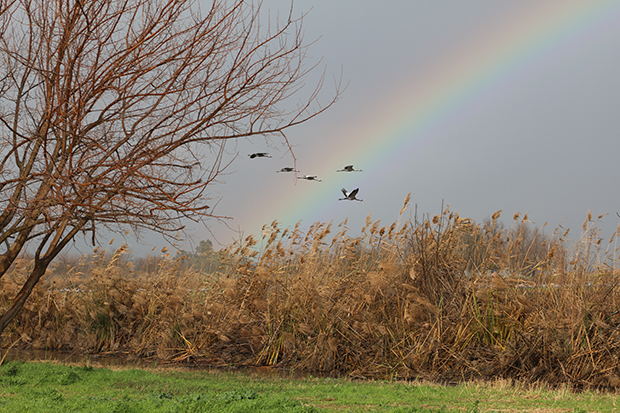

Which came first: the Catholic leader or the bird? What do you think? Answer at the bottom of this post.
In terms of location, cardinals live on the eastern side of North America. It seems if you feed them like I do (I give them black oil sunflower seeds), they came back to visit often.

I don’t know how I got so close to this particular cardinal to take his photo.

Note the fluffiness of the feathers. If you want to see a female cardinal, you can visit this old post.

A few years ago I did a cardinal watercolor painting.
Now for the source of the Northern cardinal name: the Catholic leader came first. From Wikipedia:
Cardinal, 1125, “one of the ecclesiastical princes who constitute the sacred college,” from L. cardinalis “principal, chief, essential,” from cardo (gen. cardinis) “that on which something turns or depends,” originally “door hinge.” Ecclesiastical use began for the presbyters of the chief (cardinal) churches of Rome.
The N.Amer. songbird (Cardinalis virginianus) is attested from 1678, so named for its resemblance to the red robes of the cardinals.
Here is a funny response: How the Cardinal Got Its Name, in which he says “Catholic cardinals wear red to hide spaghetti sauce stains.”
Read: How did the Northern Cardinal get its name? – In 1758 the Cardinal was one of the many species originally described by Carl Linnaeus, a Swedish botanist, physician, and zoologist, who laid the foundations for the modern scheme of binomial nomenclature, in the genus Loxia cardinalis. Loxia is derived the Greek loxos which means crosswise. Based on appearance, Linnaeus thought the Cardinal was related to the Red Crossbill. However taxonomists found the two species were not closely related. Subsequently in 1838, it was changed to the genus Cardinalis and given the scientific name Cardinalis virginianus, which means “Virginia Cardinal” because there were a lot of Cardinals in Virginia. Then in 1918, the scientific name was changed to Richmondena cardinalis to honor Charles Wallace Richmond, an American ornithologist. But in 1983 that was changed again, to Cardinalis cardinalis and the common name was also changed to “Northern Cardinal.” There are actually several bird species in the world with the name Cardinal. The term “Northern” in the common name refers to its range, as it is the only cardinal found in the Northern Hemisphere. And the “Cardinal” name was derived from the vivid red plumage of the male, which resembles the robes of the Cardinals of the Roman Catholic Church.
Finally, lots of good information on cardinals in general: What you should know about Cardinal – Northern birds
Early settlers were said to have named this bird after the Cardinal of the Catholic Church because the red of the bird reminded them of the color of the Cardinal’s robes. Since 1886, the Cardinal has considerably expanded its territory from being rarely seen north of the Ohio River to thriving over much of North America. The Northern Cardinal is quite similar to the Pyrrhuloxia, which is a southwestern species that is mostly gray with a crest tipped in red.
Thanks to Lorri (follow the link for hatching cardinal babies) for helping me find informational links.
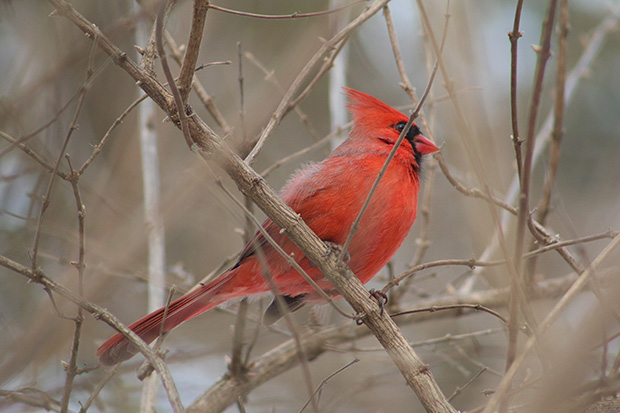
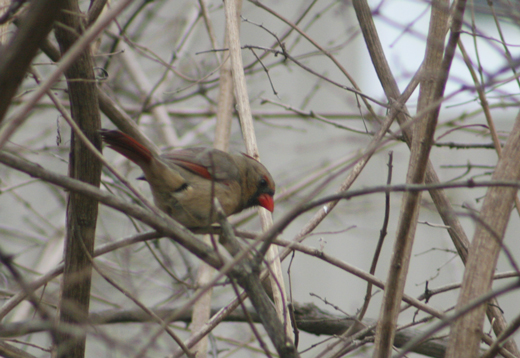
This female cardinal in my backyard was the first photograph I took in 2014. Note she is duller than her brightly colored male mate – she has one streak of red feathers to display. What was your first 2014 photograph?
Elsewhere in the Blogosphere
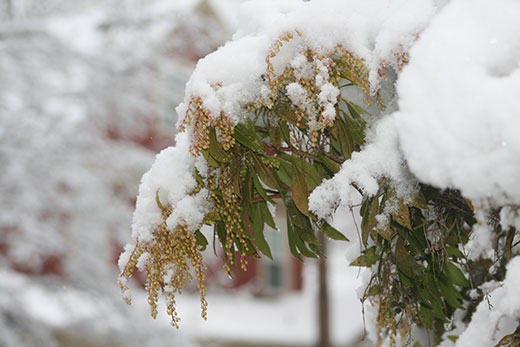
My andromeda shrub has not seen a lot of snow this year, so it was a delight last Friday when I got a chance to photograph the andromeda in snow. In the spring, the andromeda shrub produces these pretty wedding bell-like flowers. A robin once laid her eggs in my andromeda shrub.
We have gotten little snow this past winter – lots of threats and warnings, but no school has been cancelled due to snowstorms. I love photographing snow scenes, but New Jersey only gives me infrequent opportunities. I grew up in the Boston area, and they got much more snow this past winter. Anyone remember the blizzard of 1978?

The cardinals were content to visit our backyard once again and enjoy the bird feeder and branches.

This shot of the female cardinal shows a lot of her red – unlike her male partner, she is mostly brown, but when you get closer, you can see the pretty bits of red. I think it’s quite lovely.

One can see the reds of female cardinal here – love those streaks of red amongst the brown.
I enjoyed this description of the northern cardinal from Cornell’s Lab of Ornithology:
The male Northern Cardinal is perhaps responsible for getting more people to open up a field guide than any other bird. They’re a perfect combination of familiarity, conspicuousness, and style: a shade of red you can’t take your eyes off. Even the brown females sport a sharp crest and warm red accents. Cardinals don’t migrate and they don’t molt into a dull plumage, so they’re still breathtaking in winter’s snowy backyards. In summer, their sweet whistles are one of the first sounds of the morning.
I do find my cardinals tend to visit in the cold. I don’t see them in the summer.
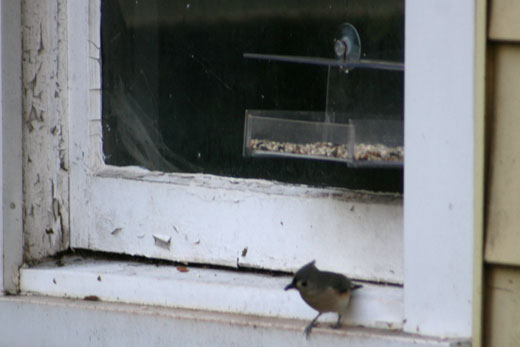
A tufted titmouse enjoyed the bird feeder I refilled two days after Hurricane Sandy came and went. I am rather burnt out of talking about post-storm problems, but in quick summary, most of Highland Park now has its power restored. We had wonderful utility workers from Florida who did much of the fixing (PSE&G was maxed out – I understand nearby Edison had workers from Ontario, Canada). So thank you, Florida and Canada. A few homes reportedly did not yet have power, but they’ve been promised fixing by today. We shall see. Meanwhile, back to the birds.
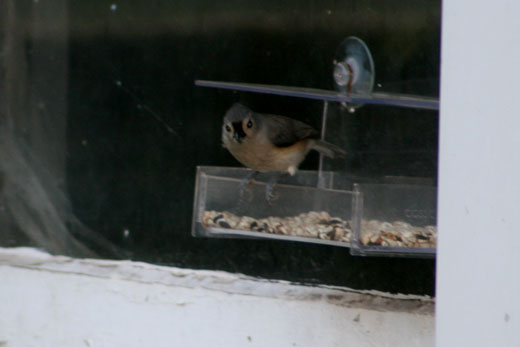
I was pleased to photograph a bird new to me – thank you, Michelle, for identifying the tufted titmouse.
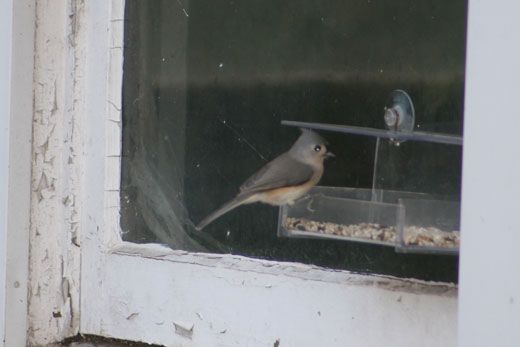
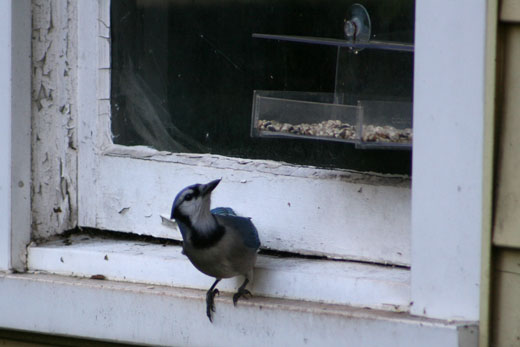
I’ve been seeing more blue jays recently than I have in the past. No signs of cardinals right now.
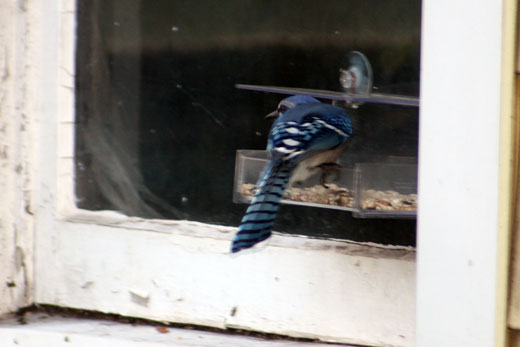
Help yourself, Mr. Blue Jay.
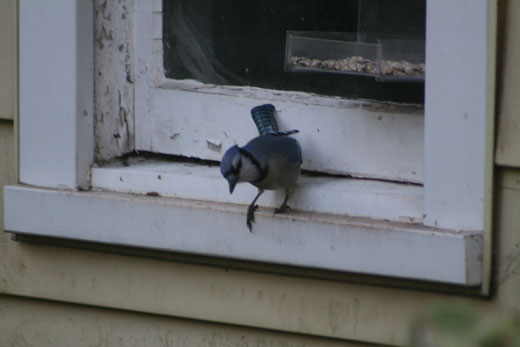
I will try my best to continue filling my bird feeder through the winter.
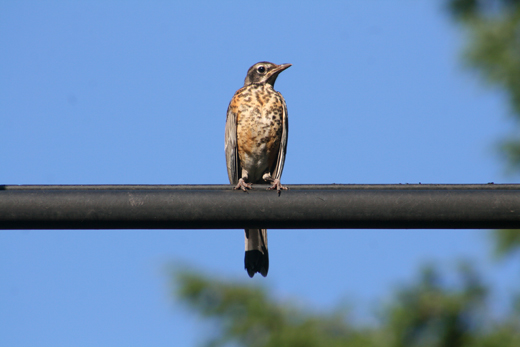
What kind of a bird has a speckled breast? I found out that some thrushes do, but this bird is a juvenile robin. Makes sense, since last summer I asked the same question about the speckled breast. Thanks, Michelle, for identifying my young robin.

Just last week I saw baby robins in a nest; when my daughter and I checked on Saturday, they were still in the nest, cawing away, and just a bit bigger. She counted four baby robins.
Do you know of a bird with speckled breast?
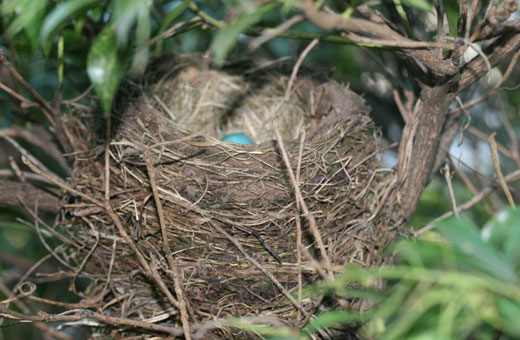
The photo shows a blue robin egg. Then the robin babies are born, and they depend on mama and papa robin. After a while, the baby robins get more feathers and fly off from the nest. A young robin is a bird with speckled breast. The mature robin has a red breast. I’ve seen robins with worms in their mouths. I’ve also seen them eating my raspberries.
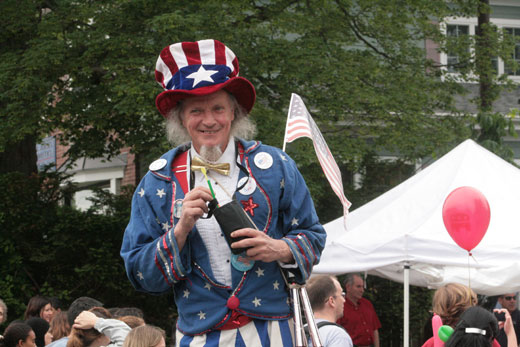
Way back in May I took this photo of Uncle Sam at the Highland Park Street Fair. The fair always seems to announce, summer is coming, summer is coming.

My daughter and I enjoyed roaming Raritan Avenue and taking in all the many booths. As you can see from her pink sweater, it wasn’t exactly summer weather.

The highlight of my summer thus far is the nest of robins growing on our front porch. Here’s a shot of a baby from last week. This week the robins already have many feathers and don’t seem as scared as they did earlier.












































